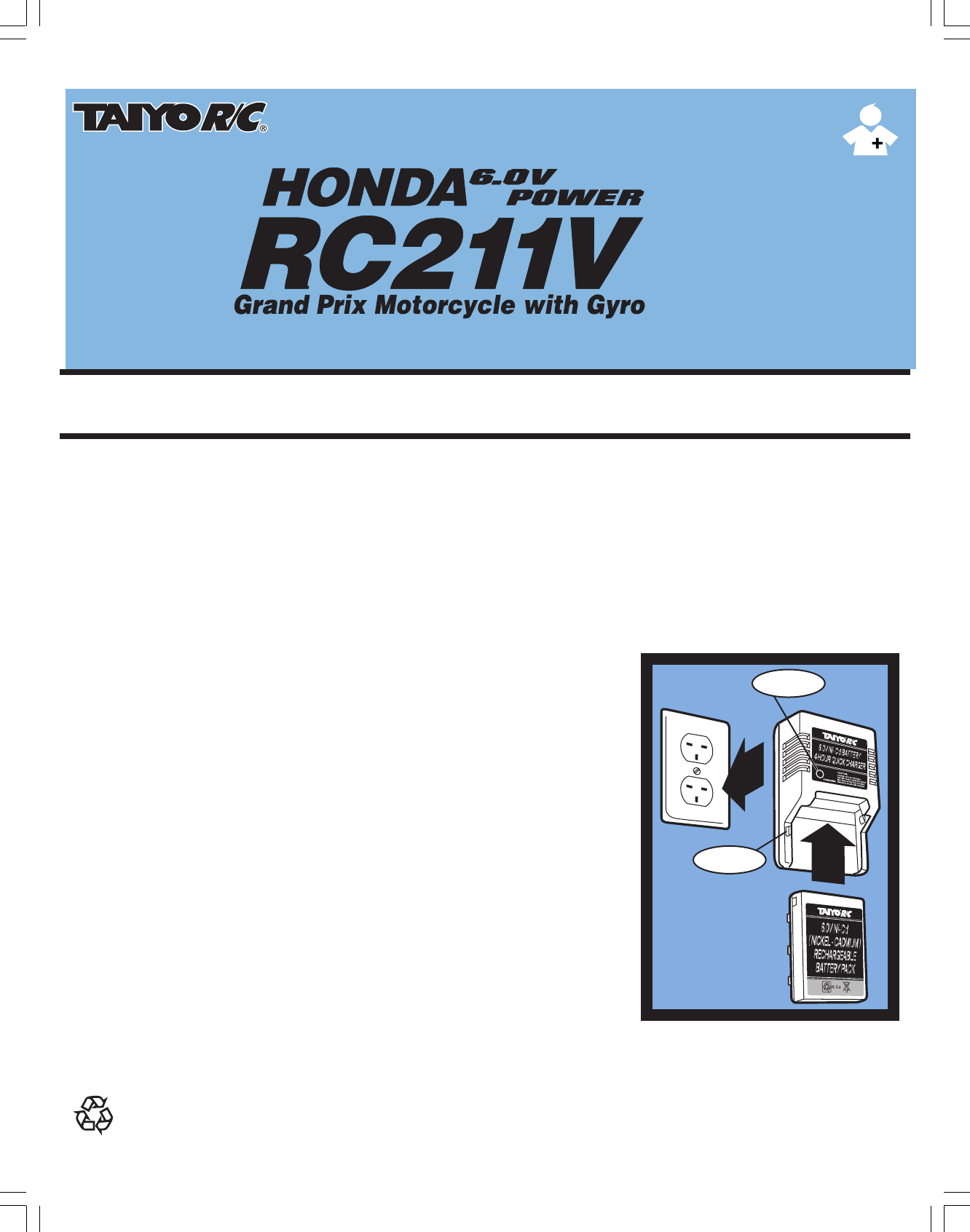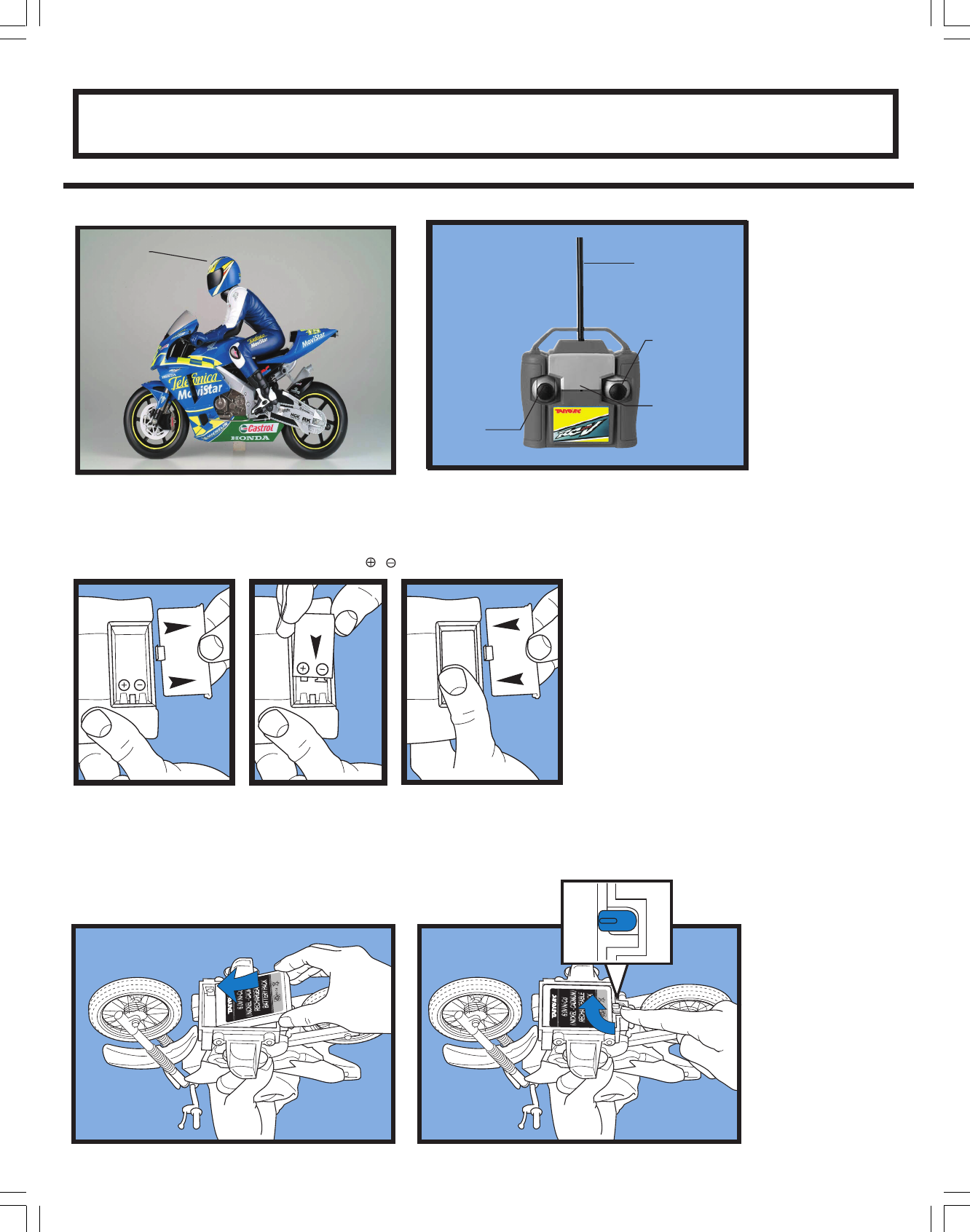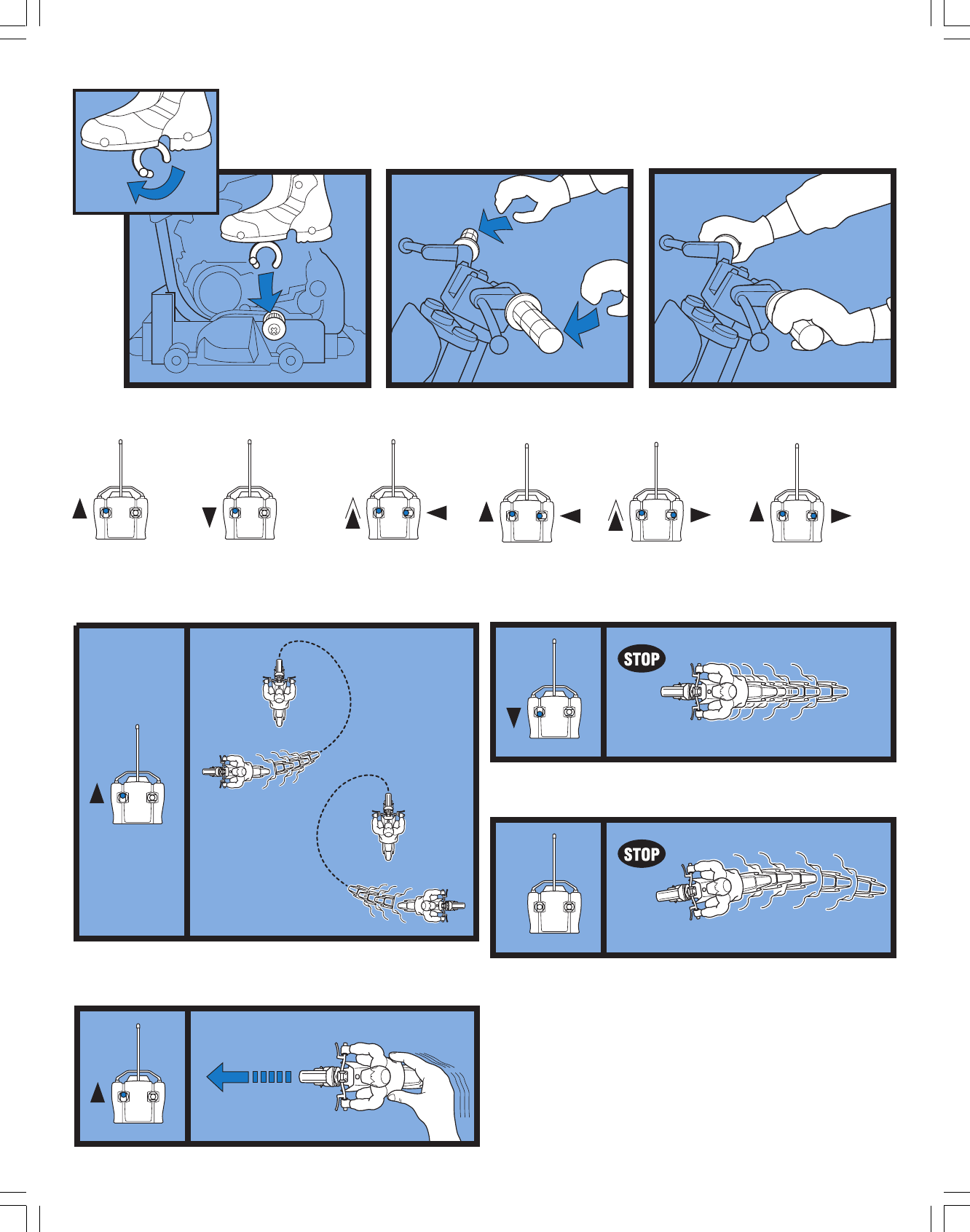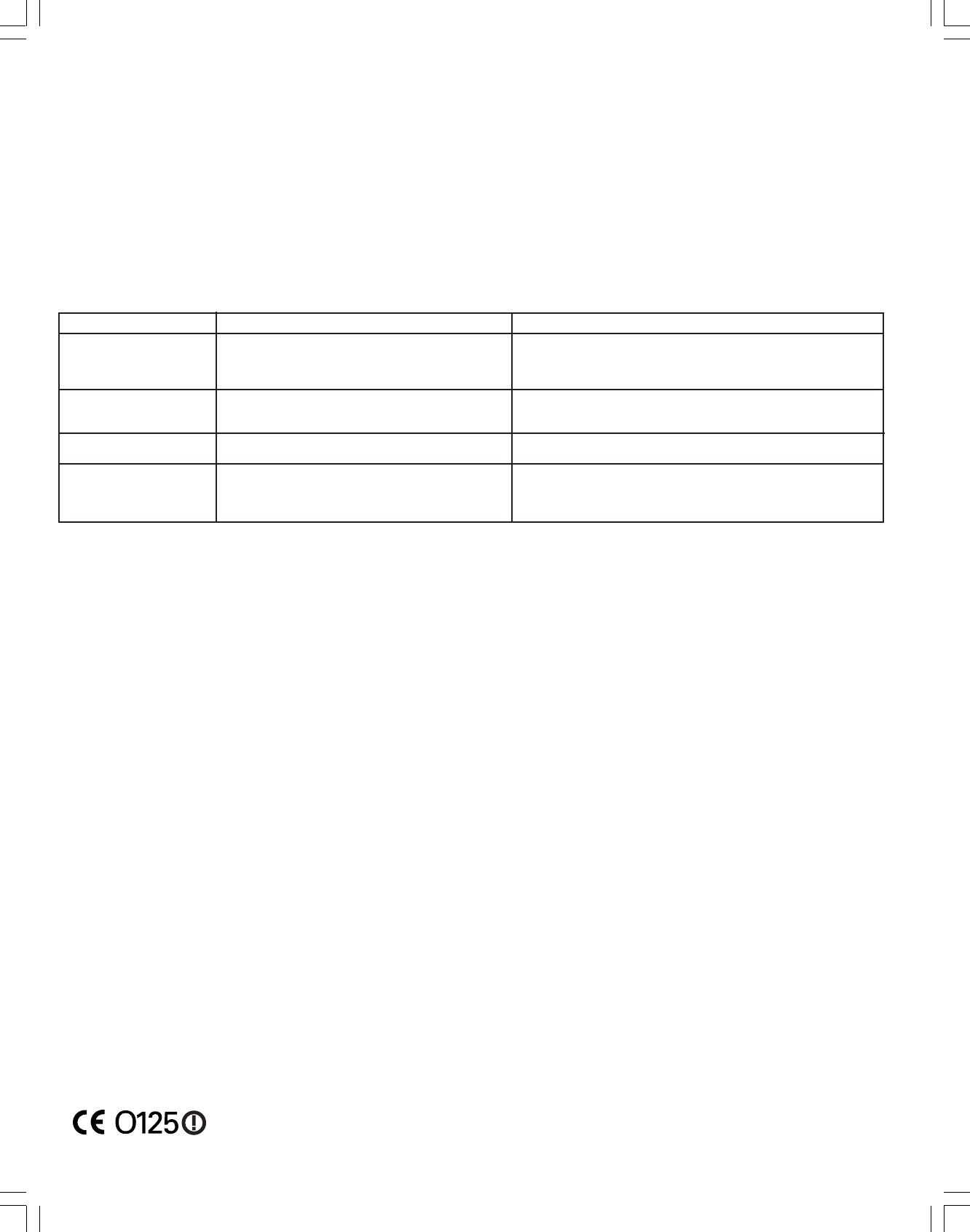Taiyo A32349R REMOTE CONTROL RECEIVER User Manual USERS MANUAL
Taiyo Co., Ltd. REMOTE CONTROL RECEIVER USERS MANUAL
Taiyo >
USERS MANUAL

O W N E R ’S M A N U A L
Thank you for your purchas e of TAIYO product.
Important! Please read your Owner's M anual all the way through before operating your vehicle. Contains im portant information---keep for future reference.
B A T T E R Y C HA R G I N G /C A R E
- M is use of the batteries can pose such risk as heat generation, explosion and leakage.
- Only batteries of the s am e or equivalent type as recom m ended are to be used.
- B atteries are to be inserted with the correct polarity.
- The supply term inals are not to be s hort-circuited.
- E xhausted batteries are to be removed from the vehicle.
- N ever im m ers e the battery in w ater or put into open flam e. Als o never attem pt to dis as s emble or
solder the battery.
- W hen the battery gets wet with water, stop using it im mediately.
- The vehicle will not operate w ithout the 6.0V rechargeable NiCd battery pack and 6.0V charger.
-This economical rechargeable s ystem is the only battery pack and charger made to power the vehicle.
- The battery charger provided is to be regularly exam ined for dam age to enclosure and other parts . In
the event of damage, the vehicle must not be used with the battery charger until the damage has
been repaired.
- R echargeable batteries are only to be recharged under adult supervision.
- R echargeable batteries are to be rem oved from the vehicle before being charged.
- N on-rechargeable batteries are not to be recharged.
- Inferior quality battery packs w ill shorten running time and m ay void the warranty.
- R echargeable up to 1000 times!
- The vehicle is not to be connected to more than the recommended number of supplies.
- Plug w all pack charger into standard 230 volt outlet.
- Click the battery pack into the charger. M ake certain the battery pack is secure in charger.
-To disconnect, push the red button on the s ide of charger and sim ultaneously slide battery pack out.
- After charging for 4 hours, the battery will feel warm . This condition is norm al for fully charged
batteries.
- N ew battery packs m us t be charged for 5 1/2 hours the first two times charged. S ubsequent charges
will only require 4 hours .
- U nlike alkaline batteries , where the pow er los s is gradual, a N iCd (nickel-cadm ium ) battery will suddenly lose much of its power. W hen this happens
it is time to recharge the battery pack.
- After use, the battery pack will be hot! W ait at leas t 20 m inutes until the battery pack cools before recharging. R echarging a warm or hot battery
pack will greatly reduce the num ber of tim es your battery pack can be recharged.
THIS PRODU CT US E S A NICK E L CADM IU M B ATTERY. M U S T B E R E CY CLE D OR DIS POS ED OF PR OPER LY.
Contact your local area office of solid w as te m anagement or other appropriate local agency for inform ation.
R E D
L I G H T
R E L E A S E
B U T T O N
S a f e t y F i r s t
-Adult supervision is recom m ended, w hen the vehicle is operated.
-To avoid danger, never drive the vehicle on streets or in crowded place. W hen playing outdoors , choose the place to play safely.
- W hen a thunder is heard while playing outdoors, im mediately s top us ing the vehicle. Otherw ise lightning s trike may be induced.
-Avoid rough handling s uch as letting the vehicle hit something or waving the vehicle in the air.
- W hen running the vehicle indoors , take due care not to break glass or damage furniture.
- K eep aw ay your fingers, hair and loose clothing from the running tires while the product is s witched "ON ".
-Avoid leaving the vehicle in a place w ith high tem perature such as the vicinity of a stove.
- Do not point the trans mitter antenna to s om ebody's head or anim als . Other wis e unex pected accident may result.
- In order to race or operate two vehicles together, the vehicles should not be operated on the sam e frequency at the s ame tim e.
- The transm itter allows easier transmis s ion of radio wave when it is held at higher position. If vehicle goes out of range, try lifting trans m itter high
into air to increase range.
- R adio interference can be caused by the operation of your vehicle near HIG H VO LTAGE E LECT R ICAL W IR E S , LARG E S TEEL R EINFORCE D CON-
CRETE B U ILDINGS and PAS S ING T R U CKS W ITH CB R A DIOS . Avoid these if poss ible.
- This product is equipped with numerous parts including precision electronic circuits . Never attempt to disassem ble or m odify the product.
N i-C d
A323 1
6

2 . B at t ery I n s talla tion
•Transmitter
S lide open the battery door on back of Transmitter, pull it toward the direction shown in the figure
while pressing lightly on its center.
Insert fresh/new 9V (6LR 61) battery with the polarity ( / ) as s hown inside battery compartment.
1 . C on t ent s
B attery Release B utton
S ide S tabilizer
(One each side)
S tand
R ear W orking
S uspension
ON /O FF S witch
Front Working
S uspension
Left S tick(Controls
forw ard,s top and
braking)
Power Indicator
-Vehicle
1. Alw ays use the fully charged 6.0V N i-Cd battery pack.
2.As preparation, turn the battery com partm ent latch in the bottom of the chass is to the lateral position.
3.Confirm that the m ain s witch is OFF. T hen set the battery pack in the bottom of the chas sis while orienting it as shown in the figure.
Tu rn the battery latch 90 degrees to fix the battery pack.
4.To rem ove the battery pack, rotate the battery com partm ent latch. E S TIM AT E D RU N
TIM E FOR THIS VEHICLE S : 20-30 M INU T E S
" S mar t Circuitry"
Your precision vehicle is equipped with advanced circuitry designed to protect electronic components under extreme operating conditions. If vehicle
stops running during use, s imply allow the joys ticks to return to their neutral pos itions for 15 to 20 seconds, then res um e norm al operation.
A323 2
Poseable Rider
Front Working
Suspension
Side Stabilizer
(One each side)
Rear Working
Suspension
Antenna
R ight S tick
(Controls s teering)
Antenna
R ight S tick
(Controls s teering)
Power Indicator
Left S tick(Controls
forw ard,s top and
braking)

3 . B ef or e O per at i o n
1.Attach the rider figure's feet as shown.
2.Attach the rider figure's hands as shown.
3.You may w ant to slide the firs t hand onto the hand grip, and s nap on the second hand.
4.Turn on the Power sw itch.
4 . O per at i n g y o ur B ik e
1. Forw ard 2. B raking 3. W ide left turn 4. S harp left turn 5. W ide right turn 6. S harp right turn
5 . S pec ia l dr i v in g c o ntr ols a n d f e a t u res
1.S tanding S tart
S et your vehicle on the ground, leaning on one of its side stabilizers .
Pus h the left s tick forward to drive s traight ahead.
1.
2.
3.
4.
5.
6.
2. Launch-S tart
Hold your vehicle steady on the ground (keeping your fingers clear of
the wheel hubs). G ently guide your vehicle forw ard while pushing the
left stick forward.
3. " S creeching" S top
W hile driving forward, quickly jam the left s tick back. Your vehicle will
brake to a quick stop with one of its side stabilizers on the ground.
4. G lide-S top
W hile driving forward, release the sticks. Your vehicle w ill glide to a
stop with one of its side s tabilizers on the ground.
A323 3

P r o b le m
Vehicle runs slow ly or
will not run.
E rratic operation or only
short range possible.
S hort battery life.
Vehicle does n't work
after going through
water or snow.
P roba ble C a u s e
Loose battery connection or vehicle switch not ON .
C o r r e c t i o n
8 . T r o uble s ho otin g
6 . R /C F a c t s
1. W hen your vehicle s tarts to lose power, it may lose functions or performance. It's tim e for fres h batteries (or a recharge). Y our vehicles 's running
tim e may change depending on your driving s tyle.
2. R adio interference can make your vehicle run badly. Interference can be caused by other R /C vehicles running on the s ame frequency; electrical
wires ; large buildings; or CB radios. Try to stay away from these!
3. Point your trans mitter antenna up-not down toward your vehicle. If your vehicle gets too far away, it w on't work properly.
4. Don't drive your vehicle in s and or through w ater or snow. If your vehicle does get wet, wipe with a towel and allow to dry completely overnight.
5. Don't store your vehicle near heat or in direct sunlight. Alw ays turn s witches OFF and rem ove all batteries for s torage.
S taatweg 111, 3621 BK B reukelen Holland
(49MHz)
PR IN TED IN CHIN A
© 2004 T aiyo Kogyo Co., Ltd. 1-23-17, Higas hiyotsugi, Kats us hika-ku, Tokyo, J apan All R ights R eserved.
Product specifications subject to change. Product may differ from illustrations.
A323
A323 4
-
-
-
-
- W eak or uncharged rechargeable battery.
- W eak transmitter battery.
-
- Radio interference likely.
- Battery not fully charged.
- W ater in the electronics area.
- Check battery connector and vehicle sw itch.
- Charge battery or replace.
- Replace with fres h 9V (6LR 61) battery.
- Change location (see point 2-R/C Facts ).
- Hold trans mitter above waist level, with antenna not touching
other object.
- Recharge N iCd battery pack. For m aximum running tim e, m ake
s ure you give your battery pack a full charge.
- Vehicle will take s everal hours to dry. Allow to dry completely
overnight before trying again.
- Operate your vehicle in a dry area. Avoid driving in water and
snow .
7 . N ote
The manufacturer is not responsible for any radio or TV interference caused by unauthorized modifications to this equipment. Such modifications
could void the user's authority to operate the equipment.